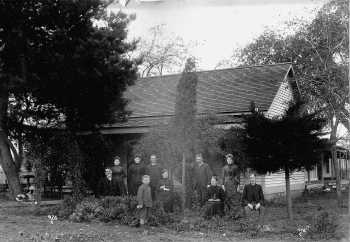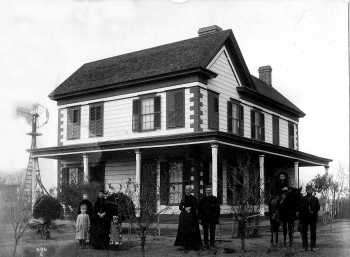Sign up for the Family Tree Newsletter! Plus, you’ll receive our 10 Essential Genealogy Research Forms PDF as a special thank you.
Get Your Free Genealogy Forms
"*" indicates required fields
Figure 1
Figure 2
How many times have you posed with your house as a backdrop to a family portrait? Probably not as often as individuals did in the 19th century. Flash photography wasn’t available until 1884. Candles and lamplight didn’t provide sufficient illumination to photograph a large group indoors, so families often chose outdoor locations. Tracey Crow’s family found one of these pictures in the attic of a family house being torn down. She submitted them to determine when they were taken, thus possibly identifying the individuals in the pictures.
ADVERTISEMENT
At full size, both images measure 8-7/8 x 6-1/4 inches. In the 19th century, the size of the print reflected the dimensions of the negative or vice versa.
Since Figure 1 lacks a photographic imprint, it is unknown whether the photographer was hired from a studio in the local town or was an itinerant photographer. Traveling photographers often carried all their equipment with them as they sought business from outlying farmers. The 476/G in the lower left-hand corner is the photographer’s mark on the glass plate negative.
Figure 2 is another family posed in front of their two-story house, taken by the Great Eastern Photographic Advertising Co. R.H. Gardiner (also spelled Gardener) managed the company in 1888 in Victoria, British Columbia, Oregon and various locations in California, circa 1885-1900. Curiously, it has a similar negative number 486/G.
ADVERTISEMENT
In Figure 2, there are again groupings of individuals. The older couple in the center are husband and wife flanked by their son and his wife and children. Having the child posed on the horse helps create balance in the photograph so that the full house appears in this portrait. Unlike the house in Figure 1, the plantings are new and so is the house. In the first photograph, the house is a much simpler dwelling surrounded by mature trees.
The clothing details of form-fitting sleeves, buttons down the front of the bodice and hairstyles make it clear that both portraits date circa 1885-1888. The draped skirts of the younger women reflect styles current for that period. In the 1890s, women’s sleeves developed fullness over the upper arm. The clothing date agrees with the years R.H. Gardiner worked in California as an itinerant photographer. Since the pictures have similar negative numbers only ten apart suggests that Gardiner’s company took both.
What’s interesting is the family resemblance between the two older men in the images. Their long faces and ears link them together. Tracey Crow knows that several brothers migrated to California. These images are of two of the brothers and their families. Consulting census documents and vital records as well as the family genealogy should establish the identity of the individuals in the pictures. She might also want to contact family related to the other brothers to see if they also own any portraits taken around the same time as these two.
ADVERTISEMENT






